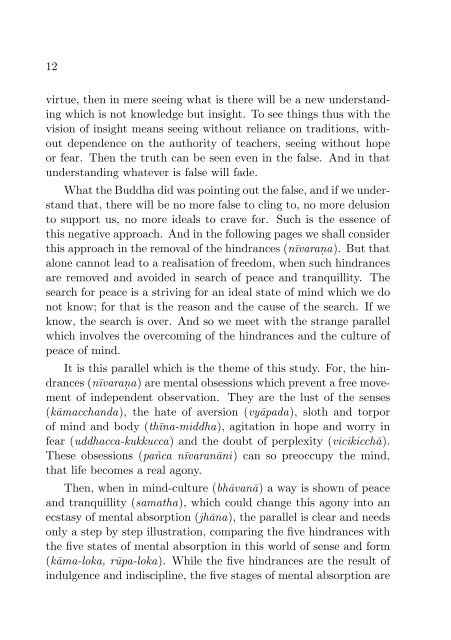Agony and Ecstasy
A comparative study of the five hindrances, together with the five states of concentration or mental absorption.
A comparative study of the five hindrances, together with the five states of concentration or mental absorption.
Create successful ePaper yourself
Turn your PDF publications into a flip-book with our unique Google optimized e-Paper software.
12<br />
virtue, then in mere seeing what is there will be a new underst<strong>and</strong>ing<br />
which is not knowledge but insight. To see things thus with the<br />
vision of insight means seeing without reliance on traditions, without<br />
dependence on the authority of teachers, seeing without hope<br />
or fear. Then the truth can be seen even in the false. And in that<br />
underst<strong>and</strong>ing whatever is false will fade.<br />
What the Buddha did was pointing out the false, <strong>and</strong> if we underst<strong>and</strong><br />
that, there will be no more false to cling to, no more delusion<br />
to support us, no more ideals to crave for. Such is the essence of<br />
this negative approach. And in the following pages we shall consider<br />
this approach in the removal of the hindrances (nīvaraṇa). But that<br />
alone cannot lead to a realisation of freedom, when such hindrances<br />
are removed <strong>and</strong> avoided in search of peace <strong>and</strong> tranquillity. The<br />
search for peace is a striving for an ideal state of mind which we do<br />
not know; for that is the reason <strong>and</strong> the cause of the search. If we<br />
know, the search is over. And so we meet with the strange parallel<br />
which involves the overcoming of the hindrances <strong>and</strong> the culture of<br />
peace of mind.<br />
It is this parallel which is the theme of this study. For, the hindrances<br />
(nīvaraṇa) are mental obsessions which prevent a free movement<br />
of independent observation. They are the lust of the senses<br />
(kāmacch<strong>and</strong>a), the hate of aversion (vyāpada), sloth <strong>and</strong> torpor<br />
of mind <strong>and</strong> body (thīna-middha), agitation in hope <strong>and</strong> worry in<br />
fear (uddhacca-kukkucca) <strong>and</strong> the doubt of perplexity (vicikicchā).<br />
These obsessions (pañca nīvaranāni) can so preoccupy the mind,<br />
that life becomes a real agony.<br />
Then, when in mind-culture (bhāvanā) a way is shown of peace<br />
<strong>and</strong> tranquillity (samatha), which could change this agony into an<br />
ecstasy of mental absorption (jhāna), the parallel is clear <strong>and</strong> needs<br />
only a step by step illustration, comparing the five hindrances with<br />
the five states of mental absorption in this world of sense <strong>and</strong> form<br />
(kāma-loka, rūpa-loka). While the five hindrances are the result of<br />
indulgence <strong>and</strong> indiscipline, the five stages of mental absorption are

















